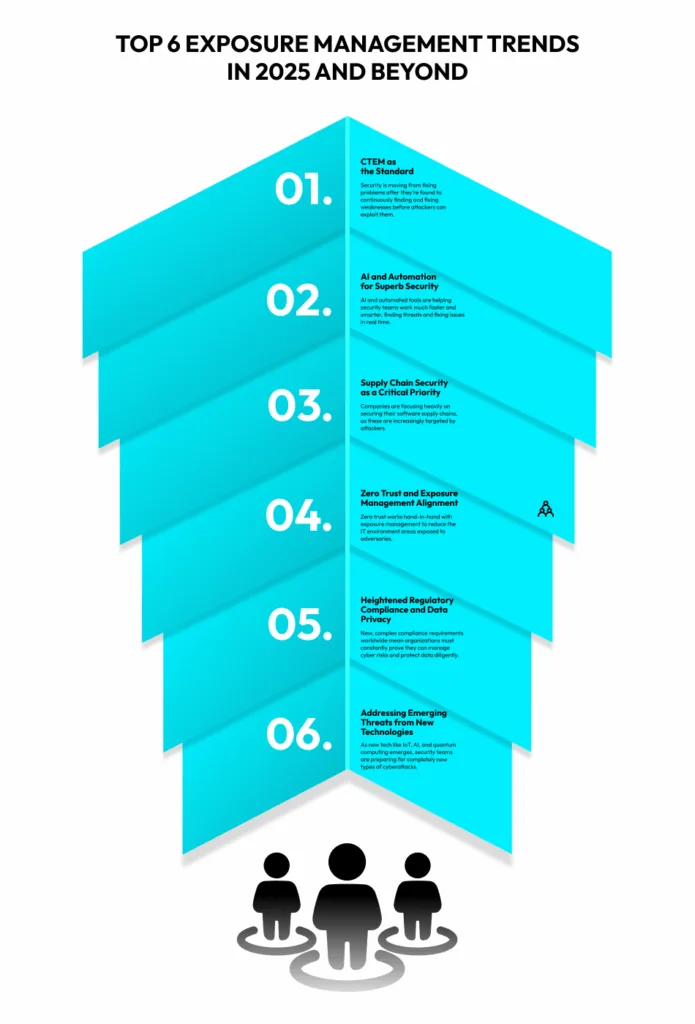Knowledge is power, which is why the knowledge of cybersecurity exposure management trends in 2025 and beyond is key to staying ahead of potential risks well into the future. It allows you to align your security program with the industry’s current best practices, making it possible to allocate resources wisely and secure compliance amid a regulatory environment that is continuously developing.
Moreover, knowledge of the latest exposure management trends arms you with an understanding of which state-of-the-art security solutions will work for you. And this understanding, apart from allowing you to address potential threats more effectively, can help you build stronger partnerships with security vendors, create a competitive advantage, and ensure long-term business growth.
For these reasons, we present to you the top 6 exposure management trends in 2025 (and beyond).

Exposure Management Trend No. 1: CTEM as the Standard
CTEM (continuous threat exposure management) is becoming a cornerstone of modern cybersecurity, and rightly so. Its core benefit, proactive cyber risk reduction, is well-known. But here are other massive advantages to think about when considering implementing CTEM, if you haven’t done it already.
Beyond CVEs and CVSS Scores
CTEM doesn’t overwhelm you with lists of CVE vulnerabilities with their CVSS scores. Instead, it concentrates on business impact and attack paths to critical assets, giving you an understanding of the attack paths that pose the highest risk to your business operations or revenue. That includes the threat of adversaries chaining together seemingly minor weaknesses to reach your crown jewels.
This approach allows you to direct your attention and efforts to tangible business risks specific to your vertical and organization, rather than looking at CVEs and CVSS scores in a contextual vacuum.
The Attacker’s Eye Perspective
CTEM emphasizes the importance of real-world attack simulation and emulation.
That doesn’t mean periodic penetration tests. Instead, CTEM promotes frequent and regular emulation of targeted cyberattacks based on confirmed adversary TTPs (tactics, techniques, and procedures). It’s the best way to identify exploitable attack paths unique to your environment that an actual threat actor may take.
In doing so, CTEM helps you move from “patch all these vulnerabilities” to the pragmatic “this is how adversaries compromise your assets; fix these exposures.”
Broken Down Silos
One of the less obvious but most powerful sides of CTEM is its role in making your organization’s security tools, data sources, and teams work in unison. The way CTEM is envisioned simply requires pulling data from various sources and tools to provide a unified and holistic view of risk exposure.
This function of an orchestration layer wouldn’t be possible without the close collaboration between multiple departments and stakeholders, including security professionals, business unit leaders, and legal, compliance, and product development team members.
In other words, CTEM forces a breakdown of traditional silos, showing clearly that cybersecurity must be a shared responsibility integrated deeply into your overall business strategy and risk management processes.
Democratized Exposure Management
While you can implement CTEM in-house, its complexity and the need for continuous operation make it a prime candidate for MSSP (managed security services) and PaaS (platform-as-a-service) offerings. As part of these offerings, CTEM democratizes access to sophisticated exposure management for organizations that lack the internal resources or expertise to build it themselves.
Cybersecurity as a Business Enabler
CTEM drives a dramatic shift in how you measure security success. It helps CISOs report on measurable reductions in realistic business risk, cyber resilience improvements, and ROI rather than the number of patched vulnerabilities and handled alerts.
This approach enables a data-driven conversation with the board and business leaders and changes the perception of cybersecurity from a cost center to an enabler of business growth and continuity.
Mitigate First, Manage Later
Although “mitigation first” is not a mainstream approach in CTEM, it is one of the most viable ways forward.
CTEM is intrinsically a proactive framework, and “mitigation first” is proactive security par excellence. The entire cycle of CTEM (scoping, discovery, prioritization, validation, mobilization) makes sense only if it leads to addressing the most critical vulnerabilities and exposures as quickly as possible. That, essentially, calls for a “mitigation first” mindset, where mitigation is the first step you take—yes, even before prioritization.
That sounds counter-intuitive; how can you mitigate potential exposure before you even assess and prioritize it?
A combination of zero-trust technology, agentic AI security, runtime protection, lockdown mode, autonomous application control, and just-in-time access make this mitigation-first approach not just possible in CTEM, but an essential capability for cyber resilience.
It’s worth noting that “mitigate first, manage later” doesn’t mean the other CTEM stages are dispensable. You’d still need to evaluate and prioritize to patch. However, a mitigation-first approach allows you to minimize the risk of exploitation while you’re going through your typical patching cycle—which can take too long, as we all know from experience—preventing adversaries from capitalizing on this window of opportunity.
In addition, “mitigate first, manage later” serves as an immediate, not delayed, protection for legacy software and any systems or applications that are, for whatever reason, non-patchable.
Exposure Management Trend No. 2: AI and Automation for Superb Security
The scale and speed of cyber threats have long surpassed the available capacities of security teams, making AI and automation necessary for exposure management.
AI gives defenders remarkable analytical power. From advanced threat intelligence and anomaly detection to predictive analytics that anticipates potential attack paths, AI agents can help security teams process vast datasets, identify subtle indicators of compromise, and identify potential vulnerabilities with precision and speed impossible through manual methods.
When fueled by AI insights, automated security operations enable real-time prevention and immediate mitigation. They allow you to counter threats at machine speed and guarantee consistent policy enforcement as well as swift action, aiming at zero dwell time for attackers.
Agentic AI makes it possible for autonomous systems to perform critical tasks without human intervention—continuous monitoring, vulnerability identification, and real-time remediation/mitigation. By operating independently, agentic AI reduces the burden on security teams and accelerates response times to emerging threats.
Research has already indicated the benefits of AI for security operations, information protection, and endpoint management, noticing advancements in:
- The number of security alerts per incident
- Probability of security incident reopenings
- Time to classify a data loss prevention alert
- Time to resolve device policy conflicts
The combined force of AI and automation is transforming exposure management into a continuously optimizing, self-defending mechanism, resulting in a more resilient security posture.
Exposure Management Trend No. 3: Supply Chain Security as a Critical Priority
Organizations are no longer concerned with their immediate perimeter. The weakest link can often be found deep within their extended network of vendors, partners, and third-party software providers.
Threat actors are targeting these trusted relationships more and more, leveraging a single point of entry within a supplier’s compromised system to launch widespread infiltrations into dozens, hundreds, or sometimes thousands of downstream clients. These insidious cyberattacks can easily fly under the radar, especially when the third-party software vendor is a highly prominent IT platform, and make the identification and mitigation of the security risk ten times harder.
Software supply chain security as a critical priority in 2025 assumes an increase in budget allocation and strategic focus on thorough vetting processes for all third-party vendors. That, in turn, entails:
- Rigorous security assessments and independent audits
- Contractual agreements with clear security obligations
- SBOMs (software bill of materials)
- Continuous monitoring of supplier security postures
- Third-party risk integrated into your exposure management program
- Improved open-source security practices
- Secure by design principles
- Contingency plans for supply chain disruptions
Changes for the better, like the implementation of the practices from this list, allow you to transform software supply chain security from a compliance checklist item into a serious effort to reduce your overall exposure.
Exposure Management Trend No. 4: Zero Trust and Exposure Management Alignment
Zero trust treats all human and non-human entities, whether inside or outside the network perimeter, as untrusted until proven otherwise. By denying access by default, it decreases the implicit trust zones—employee workstations, authentication servers, databases, build environments, and similar—that attackers often take advantage of.
A zero-trust approach is an undeniable force in enhancing an organization’s ability to manage threat exposure through security controls, mechanisms, and techniques like:
- JIT (just-in-time) access
- Rigorous IAM (identity and access management)
- MFA (multi-factor authentication)
- Micro-segmentation
- Automated trusted policy enforcement
These all contribute directly to the exposure management objective of identifying and mitigating exploitable pathways. Besides, even if an initial compromise happens, when access to critical assets is authenticated, authorized, and continuously monitored, attackers will have a hard time moving laterally, limiting the blast radius of any potential breach.
This is the exact reason why security vendors, such as Virsec, have integrated zero trust into their platforms—to enhance your exposure management capabilities.
Exposure Management Trend No. 5: Heightened Regulatory Compliance and Data Privacy
What began as foundational regulations in the form of GDPR and CCPA has become a multifaceted web of legislation. DORA, NIS2, the AI Act, the SEC’s cybersecurity disclosure rules, the surge in state-level privacy laws across the US, and new acts in countries like India and Canada, have turned the 2025 regulatory landscape into a maze of strict compliance requirements.
This state directly affects exposure management. To secure compliance, organizations now must:
- Adopt a holistic exposure management approach, such as CTEM
- Boost incident response capabilities, e.g., through an elaborated incident response plan
- Stay informed of regulatory changes
- Use technology for compliance monitoring
- Carry out thorough risk assessments and audit trails
- Ensure third-party security
- Implement detailed incident reporting
- Introduce continuous monitoring
- Apply automated compliance validation
- Provide evidence of due diligence
Exposure Management Trend No. 6: Addressing Emerging Threats from New Technologies
The enormous pace of technological advancement, while driving innovation and efficiency, introduces entirely new attack vectors and intensifies existing cyber risks.
The proliferation of IoT devices and APIs, often with minimal built-in security and complex update mechanisms, colossally expands the current attack surface. Moreover, as 5G networks, with their increased speed and distributed edge computing, enable massive IoT connectivity, they introduce new vulnerabilities springing from chained dependencies and the sheer volume of interconnected devices.
But perhaps the most transformative and complex threats stem from the duality of artificial intelligence. AI helps defenders tremendously, but it also allows cybercriminals to automate vulnerability identification, launch convincing phishing campaigns with extremely high success rates, and create adaptive malware that evades detection.
As of 2025, quantum computing does not yet pose a concrete, immediate critical risk in the real world. Today’s quantum computers are still small and noisy, and they lack stable qubits to break widely used cryptographic algorithms like RSA or ECC.
However, possible quantum computing threats are definitely on the horizon. For instance, sensitive information with long confidentiality requirements, like state secrets, can be recorded today and decrypted later once quantum computing matures. This is known as the “harvest now, decrypt later” risk, and it’s not as far-fetched as it may seem now.
In these circumstances, effective exposure management calls for an intentional and dedicated effort to research, anticipate, and build defenses against threats that are fundamentally different from those we’ve grown accustomed to. That is the reason why the cybersecurity community is already actively working on solutions like:
- Post-quantum cryptography, i.e., new algorithms designed to withstand future quantum attacks
- AI- and ML-based defense/protection for real-time threat discovery, anomaly detection, and automated response, as well as identification of deepfake content, AI-generated phishing attempts, and automated vulnerability exploitation
Conclusion
As the security threat landscape becomes increasingly rough and volatile, organizations across the US are embracing these six exposure management trends. Prevention is the primary goal, but since it’s not always achievable, a prompt response is the next imperative. And they’re both possible through continuous exposure management.
Eliminate 90% of your threat exposure instantly with Virsec’s OTTOGUARD.AI’s workload patchless mitigation. See it in action. Book your demo today.
FAQs
Exposure management (or CTEM) differs from traditional vulnerability management by taking a broader, attacker-centric, and business-contextualized approach to identify, prioritize, and mitigate all forms of exploitability across the entire attack surface, not just known software flaws.
AI and automation enable exposure management to:
- Process vast datasets at unprecedented speed
- Identify complex vulnerabilities and exploitable attack paths
- Enable real-time detection, quick prioritization, and autonomous mitigation
This way, they decrease the manual burden and alert fatigue of your security team, at the same time increasing its efficiency.
It leads to continuous visibility into your attack surface, prompt mitigation, and verifiable data on risk reduction presented in reports, which helps you demonstrate your compliance and data protection efforts.




